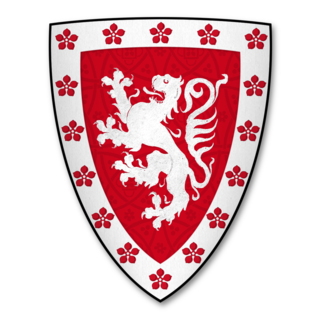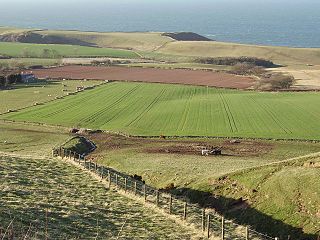Related Research Articles

Alexander II was King of Alba (Scotland) from 1214 until his death. He concluded the Treaty of York (1237) which defined the boundary between England and Scotland, largely unchanged today.

The Declaration of Arbroath is the name usually given to a letter, dated 6 April 1320 at Arbroath, written by Scottish barons and addressed to Pope John XXII. It constituted King Robert I's response to his excommunication for disobeying the pope's demand in 1317 for a truce in the First War of Scottish Independence. The letter asserted the antiquity of the independence of the Kingdom of Scotland, denouncing English attempts to subjugate it.

William the Lion, sometimes styled William I and also known by the nickname Garbh, 'the Rough', reigned as King of Alba from 1165 to 1214. His almost 49-year-long reign was the longest for a Scottish monarch before the Union of the Crowns in 1603.
Margaret, known as the Maid of Norway, was the queen-designate of Scotland from 1286 until her death. As she was never inaugurated, her status as monarch is uncertain and has been debated by historians.

The Wars of Scottish Independence were a series of military campaigns fought between the Kingdom of Scotland and the Kingdom of England in the late 13th and 14th centuries.

John Balliol or John de Balliol, known derisively as Toom Tabard, was King of Scots from 1292 to 1296. Little is known of his early life. After the death of Margaret, Maid of Norway, Scotland entered an interregnum during which several competitors for the Crown of Scotland put forward claims. Balliol was chosen from among them as the new King of Scotland by a group of selected noblemen headed by King Edward I of England.

Patrick de Dunbar, 9th Earl of March, was a prominent Scottish magnate during the reigns of Robert the Bruce and David II.

Archibald Douglas, 6th Earl of Angus was a Scottish nobleman active during the reigns of James V and Mary, Queen of Scots. He was the son of George, Master of Angus, who was killed at the Battle of Flodden, and succeeded as Earl of Angus on the death of his grandfather, Archibald.
When the crown of Scotland became vacant in September 1290 on the death of the seven-year-old Queen Margaret, 13 claimants to the throne came forward. Those with the most credible claims were John Balliol; Robert de Brus, 5th Lord of Annandale ; John Hastings, 1st Baron Hastings; and Floris V, Count of Holland.

Agnes Randolph, Countess of Dunbar and March, known as Black Agnes for her dark complexion, was the wife of Patrick, 9th Earl of Dunbar and March. She is buried in the vault near Mordington House.
Patrick IV, 8th Earl of Dunbar and Earl of March, sometimes called Patrick de Dunbar "8th" Earl of March, was the most important magnate in the border regions of Scotland. He was one of the Competitors for the Crown of Scotland.
Patrick III, 7th Earl of Dunbar was lord of the feudal barony of Dunbar and its castle, which dominated East Lothian, and the most important military personage in the Scottish Borders.

Clan Dunbar is a Scottish clan of the Scottish Lowlands.

Eustace de Vesci (1169–1216) was an English lord of Alnwick Castle, and a Magna Carta surety. He also held lands in Sprouston, Roxburghshire, Scotland as brother in-law to King Alexander II of Scotland. Eustace was a leader during the Barons' War in 1215 and was killed while undertaking a siege of Barnard Castle in 1216.

The Battle of Piperdean was an engagement in the Scottish Borders, fought on 10 September 1435 between the Kingdom of Scotland and the Kingdom of England.
The Battle of Lochmaben Fair was an engagement in Lochmaben, Scotland, on 22 July 1484 between Scottish loyalists to James III of Scotland and the rebels Alexander Stewart, Duke of Albany and James Douglas, 9th Earl of Douglas, leading cavalry from England. Both exiles from Scotland, Albany and Douglas invaded with permission but not support of Richard III of England, hoping to encourage rebellion against James. Instead, they were met with armed resistance. The loyalists took the day. Douglas was captured and Albany forced to retreat.
George Ridpath was a Scottish journalist, who wrote in the Whig interest.
The Galloway revolt of 1234–1235 was an uprising in Galloway during 1234–1235, led by Tomás mac Ailein and Gille Ruadh. The uprising was in response to the succession of Alan of Galloway, whereby King Alexander II of Scotland ordered Galloway to be divided the amongst Alan's three heiresses under Norman feudal law. This judgement excluded Alan's illegitimate son Tomás, who believed he was the rightful heir under the Gaelic system of tanistry. Alexander II responded by leading an army into Galloway to crush the rebellion. The Scottish army was almost routed, however was saved by the arrival of Fearchar, Earl of Ross and his forces. Walter Comyn, Lord of Badenoch was left to mop up the revolt, however was forced to abandon the region. Patrick II, Earl of Dunbar led another army in 1235, with Adam, Abbot of Melrose, and Gilbert, Bishop of Galloway and forced the submission of Tomás and Gille.
Events from the 1290s in Scotland.
References
- Ridpath, George; The Border History of England and Scotland, P. Wright, 1810.